Effect of Potassium Sorbate and Ultrasonic Treatment on the Properties of Fish Scale Collagen/Polyvinyl Alcohol Composite Film
Abstract
1. Introduction
2. Results and Discussion
2.1. SEM
2.2. Transparency and Color of the Films
2.3. Mechanical Properties
2.4. FTIR Analysis
2.5. WVTR
2.6. Antibacterial Testing
2.7. Effect of Ultrasonic Treatment Film Forming Solution on the Performance of the Composite Film
3. Materials and Methods
3.1. Materials
3.2. Preparation of KS-Col-PVA Composite Films
3.3. Scanning Electronic Microscope (SEM)
3.4. Transparency and Color of Composite Films
3.5. Mechanical Properties
3.6. Fourier Transform Infrared (FTIR) Analysis
3.7. Water Vapor Transmission Rate and Water Solubility
3.8. Antibacterial Tests
3.9. Statistical Analysis
4. Conclusions
Author Contributions
Funding
Conflicts of Interest
References
- Bernardini, R.D.; Harnedy, P.; Bolton, D.; Kerry, J.; O’Neill, E.; Mullen, A.M.; Hayes, M. Antioxidant and antimicrobial peptidic hydrolysates from muscle protein sources and by-products. Food Chem. 2011, 124, 1296–1307. [Google Scholar] [CrossRef]
- Bonilla, J.; Fortunati, E.; Atarés, L.; Chiralt, A.; Kenny, J.M. Physical, structural and antimicrobial properties of poly vinyl alcohol–chitosan biodegradable films. Food Hydrocoll. 2014, 35, 463–470. [Google Scholar] [CrossRef]
- Liu, B.; Xu, H.; Zhao, H.; Liu, W.; Zhao, L.; Li, Y. Preparation and characterization of intelligent starch/PVA films for simultaneous colorimetric indication and antimicrobial activity for food packaging applications. Carbohydr. Polym. 2017, 157, 842–849. [Google Scholar] [CrossRef] [PubMed]
- Liu, Y.; Wang, S.; Lan, W. Fabrication of antibacterial chitosan-PVA blended film using electrospray technique for food packaging applications. Int. J. Biol. Macromol. 2018, 107, 848–854. [Google Scholar] [CrossRef] [PubMed]
- Uz, M.; Altınkaya, S.A. Development of mono and multilayer antimicrobial food packaging materials for controlled release of potassium sorbate. LWT-Food Sci. Technol. 2011, 44, 2302–2309. [Google Scholar] [CrossRef]
- Alzate, P.; Miramont, S.; Flores, S.; Gerschenson, L. Effect of the potassium sorbate and carvacrol addition on the properties and antimicrobial activity of tapioca starch - hydroxypropyl methylcellulose edible films. Starch-Starke 2016, 69. [Google Scholar] [CrossRef]
- Kowalczyk, D.; Kordowska-Wiater, M.; Złotek, U.; Skrzypek, T. Antifungal resistance and physicochemical attributes of apricots coated with potassium sorbate-added carboxymethyl cellulose-based emulsion. Int. J. Food Sci. Tech. 2018, 53, 728–734. [Google Scholar] [CrossRef]
- Sousa, G.M.; Yamashita, F.; Soares Júnior, M.S. Application of biodegradable films made from rice flour, poly(butylene adipate-co-terphthalate), glycerol and potassium sorbate in the preservation of fresh food pastas. LWT-Food Sci. Technol. 2016, 65, 39–45. [Google Scholar] [CrossRef]
- Gunaydin, S.; Karaca, H.; Palou, L.; de la Fuente, B.; Pérez-Gago, M.B. Effect of hydroxypropyl Methylcellulose-Beeswax composite edible coatings formulated with or without antifungal agents on physicochemical properties of plums during cold storage. J. Food Quality 2017, 2017, 1–9. [Google Scholar] [CrossRef]
- Türe, H.; Gällstedt, M.; Hedenqvist, M.S. Antimicrobial compression-moulded wheat gluten films containing potassium sorbate. Food Res. Int. 2012, 45, 109–115. [Google Scholar] [CrossRef]
- Pranoto, Y.; Rakshit, S.K.; Salokhe, V.M. Enhancing antimicrobial activity of chitosan films by incorporating garlic oil, potassium sorbate and nisin. LWT- Food Sci. Technol. 2005, 38, 859–865. [Google Scholar] [CrossRef]
- Lopez, O.V.; Giannuzzi, L.; Zaritzky, N.E.; Garcia, M.A. Potassium sorbate controlled release from corn starch films. Mater. Sci. Eng. C Mater. Biol. Appl. 2013, 33, 1583–1591. [Google Scholar]
- Barzegar, H.; Azizi, M.H.; Barzegar, M.; Hamidi-Esfahani, Z. Effect of potassium sorbate on antimicrobial and physical properties of starch-clay nanocomposite films. Carbohydr. Polym. 2014, 110, 26–31. [Google Scholar] [CrossRef] [PubMed]
- Sousa, G.M.; Soares Junior, M.S.; Yamashita, F. Active biodegradable films produced with blends of rice flour and poly(butylene adipate co-terephthalate): Effect of potassium sorbate on film characteristics. Mater. Sci. Eng. C Mater. Biol. Appl. 2013, 33, 3153–3159. [Google Scholar] [CrossRef] [PubMed]
- Chevalier, E.; Chaabani, A.; Assezat, G.; Prochazka, F.; Oulahal, N. Casein/wax blend extrusion for production of edible films as carriers of potassium sorbate—A comparative study of waxes and potassium sorbate effect. Food Packaging Shelf. 2018, 16, 41–50. [Google Scholar] [CrossRef]
- Remedio, L.N.; Silva dos Santos, J.W.; Vieira Maciel, V.B.; Yoshida, C.M.P.; Aparecida de Carvalho, R. Characterization of active chitosan films as a vehicle of potassium sorbate or nisin antimicrobial agents. Food Hydrocoll. 2019, 87, 830–838. [Google Scholar] [CrossRef]
- Sayanjali, S.; Ghanbarzadeh, B.; Ghiassifar, S. Evaluation of antimicrobial and physical properties of edible film based on carboxymethyl cellulose containing potassium sorbate on some mycotoxigenic Aspergillus species in fresh pistachios. LWT-Food Sci. Technol. 2011, 44, 1133–1138. [Google Scholar] [CrossRef]
- Shi, D.; Liu, F.; Yu, Z.; Chang, B.; Goff, H.D.; Zhong, F. Effect of aging treatment on the physicochemical properties of collagen films. Food Hydrocoll. 2019, 87, 436–447. [Google Scholar] [CrossRef]
- Kozlowska, J.; Kaczmarkiewicz, A. Collagen matrices containing poly(vinyl alcohol) microcapsules with retinyl palmitate – Structure, stability, mechanical and swelling properties. Polym. Degrad. Stabil. 2019, 161, 108–113. [Google Scholar] [CrossRef]
- Shen, X.L.; Wu, J.M.; Chen, Y.; Zhao, G. Antimicrobial and physical properties of sweet potato starch films incorporated with potassium sorbate or chitosan. Food Hydrocoll. 2010, 24, 285–290. [Google Scholar] [CrossRef]
- Basch, C.Y.; Jagus, R.J.; Flores, S.K. Physical and antimicrobial properties of tapioca starch-HPMC edible films incorporated with Nisin and/or potassium sorbate. Food Bioprocess Tech. 2012, 6, 2419–2428. [Google Scholar] [CrossRef]
- Muangrat, R.; Nuankham, C. Production of flour film from waste flour during noodle production and its application for preservation of fresh strawberries. CyTA–J. Food 2018, 16, 525–536. [Google Scholar] [CrossRef]
- Cheng, W.; Chen, J.; Liu, D.; Ye, X.; Ke, F. Impact of ultrasonic treatment on properties of starch film-forming dispersion and the resulting films. Carbohyd. Polym. 2010, 81, 707–711. [Google Scholar] [CrossRef]
- Liu, Y.; Wang, S.; Lan, W.; Qin, W. Development of ultrasound treated polyvinyl alcohol/tea polyphenol composite films and their physicochemical properties. Ultrason. Sonochem. 2019, 51, 386–394. [Google Scholar] [CrossRef]
- Gao, W.; Dong, H.; Hou, H.; Zhang, H. Effects of clays with various hydrophilicities on properties of starch–clay nanocomposites by film blowing. Carbohyd. Polym. 2012, 88, 321–328. [Google Scholar] [CrossRef]
- Pérez, L.M.; Soazo, M.d.V.; Balagué, C.E.; Rubiolo, A.C.; Verdini, R.A. Effect of pH on the effectiveness of whey protein/glycerol edible films containing potassium sorbate to control non-O157 shiga toxin-producing Escherichia coli in ready-to-eat foods. Food Control 2014, 37, 298–304. [Google Scholar] [CrossRef]
- Flores, S.; Famá, L.; Rojas, A.M.; Goyanes, S.; Gerschenson, L. Physical properties of tapioca-starch edible films: Influence of filmmaking and potassium sorbate. Food Res. Int. 2007, 40, 257–265. [Google Scholar] [CrossRef]
- Soukoulis, C.; Singh, P.; Macnaughtan, W.; Parmenter, C.; Fisk, I.D. Compositional and physicochemical factors governing the viability of Lactobacillus rhamnosus GG embedded in starch-protein based edible films. Food Hydrocoll. 2016, 52, 876–887. [Google Scholar] [CrossRef] [PubMed]
- Liang, T.; Sun, G.; Cao, L.; Li, J.; Wang, L. Rheological behavior of film-forming solutions and film properties from Artemisia sphaerocephala Krasch. gum and purple onion peel extract. Food Hydrocoll. 2018, 82, 124–134. [Google Scholar] [CrossRef]
- Threepopnatkul, P.; Wongnarat, C.; Intolo, W.; Suato, S.; Kulsetthanchalee, C. Effect of TiO2 and ZnO on thin film properties of PET/PBS blend for food packaging applications. Energy Procedia 2014, 56, 102–111. [Google Scholar] [CrossRef]
Sample Availability: Samples of the compounds are not available from the authors. |
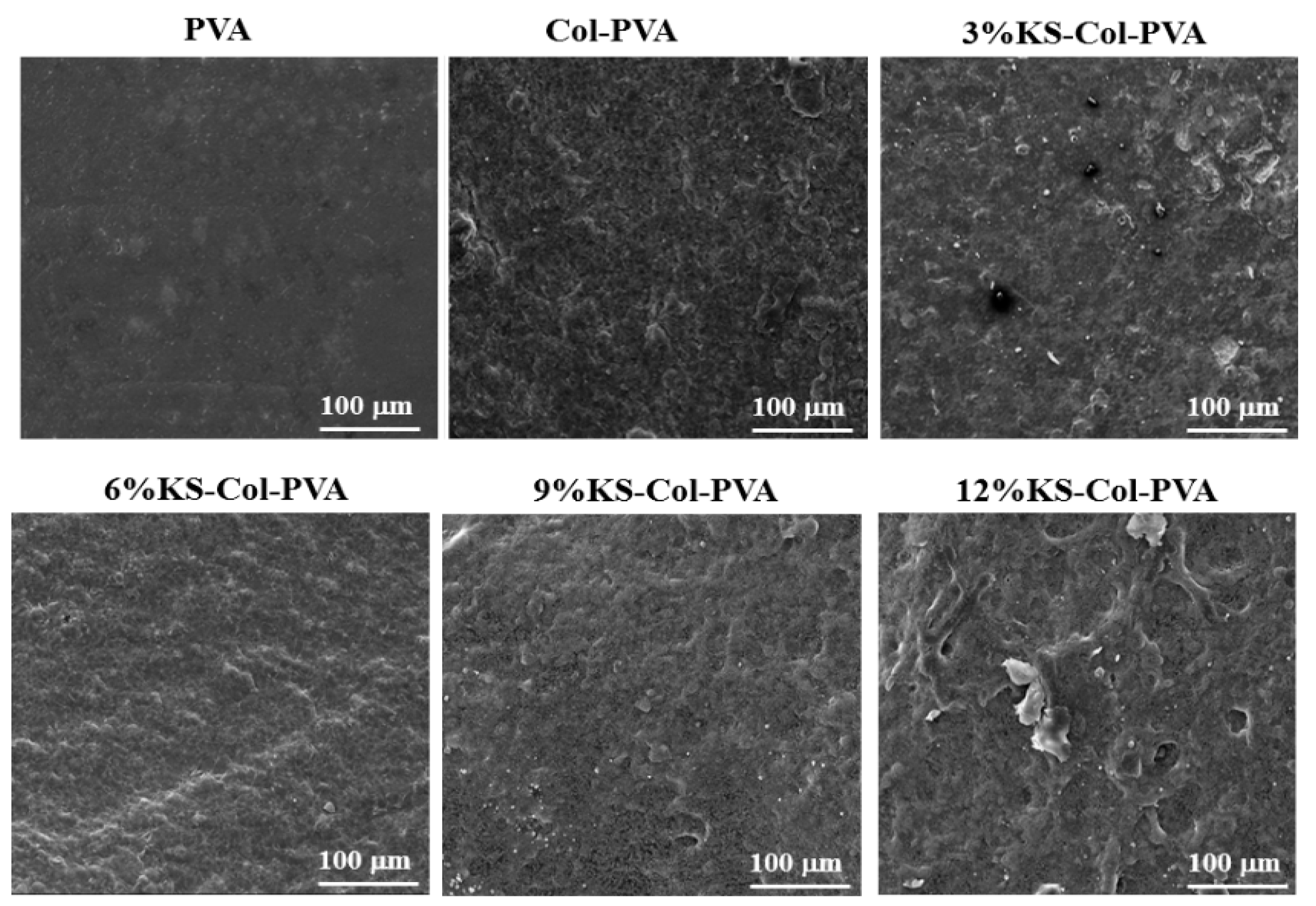

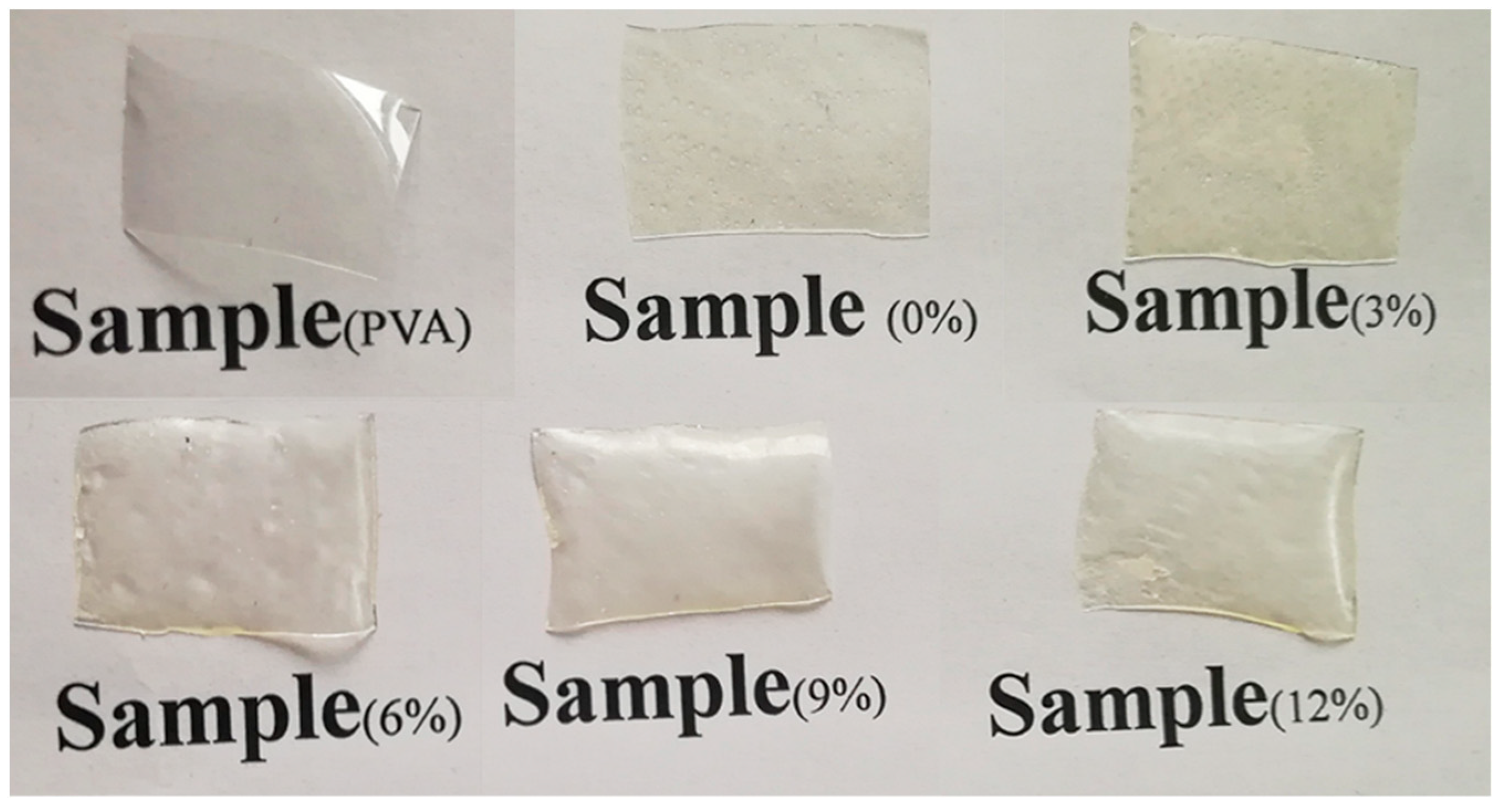
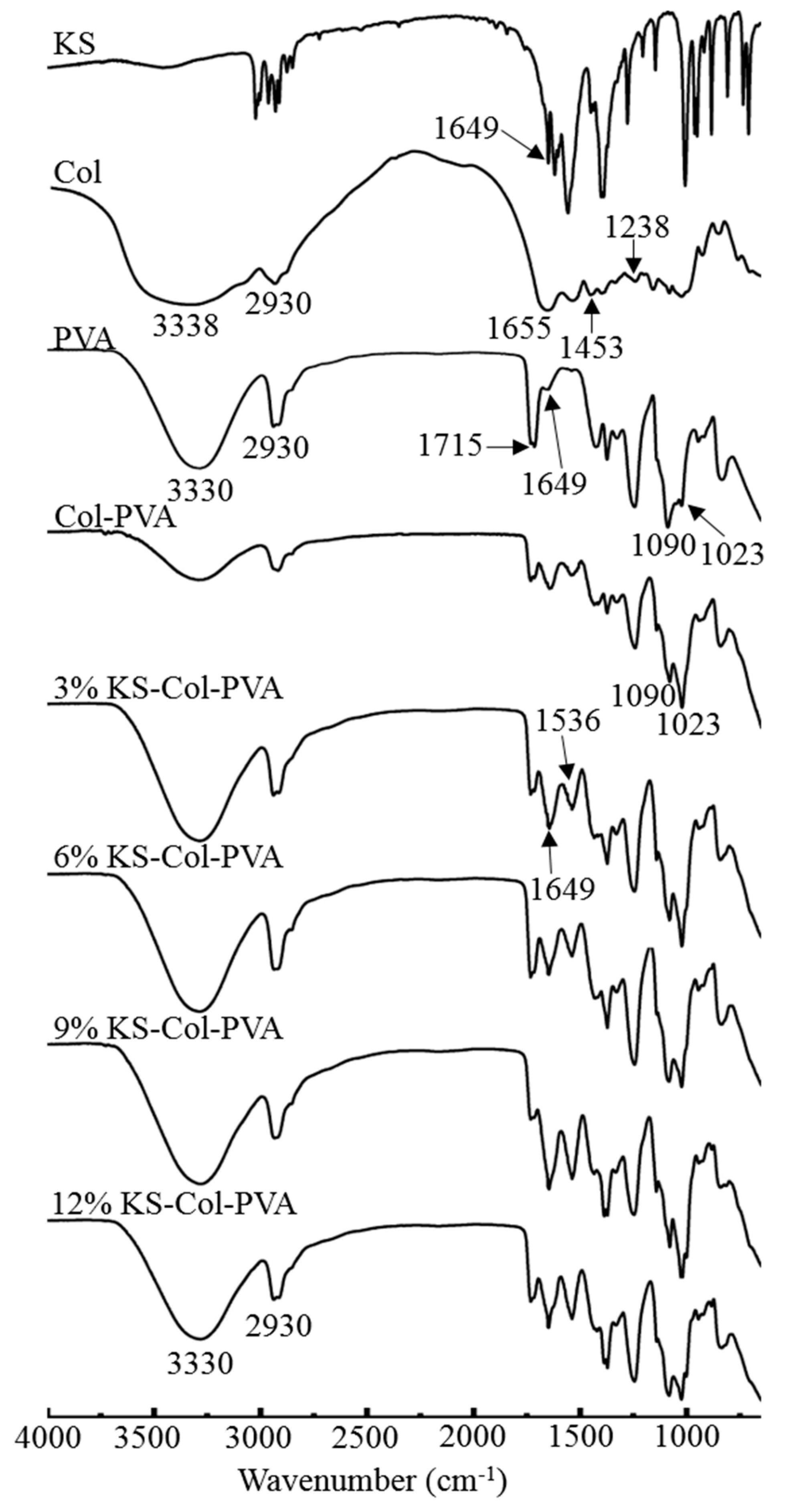
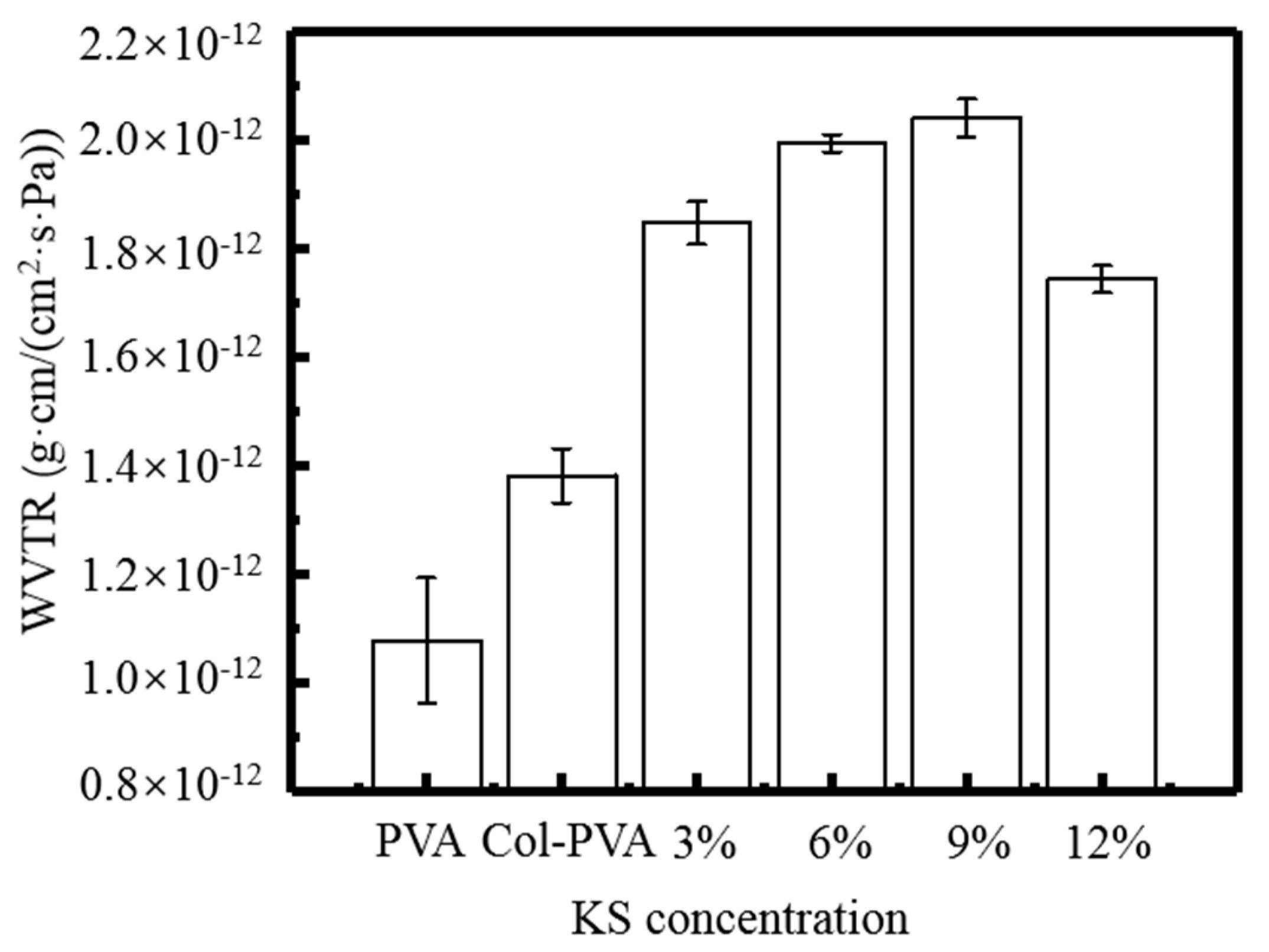
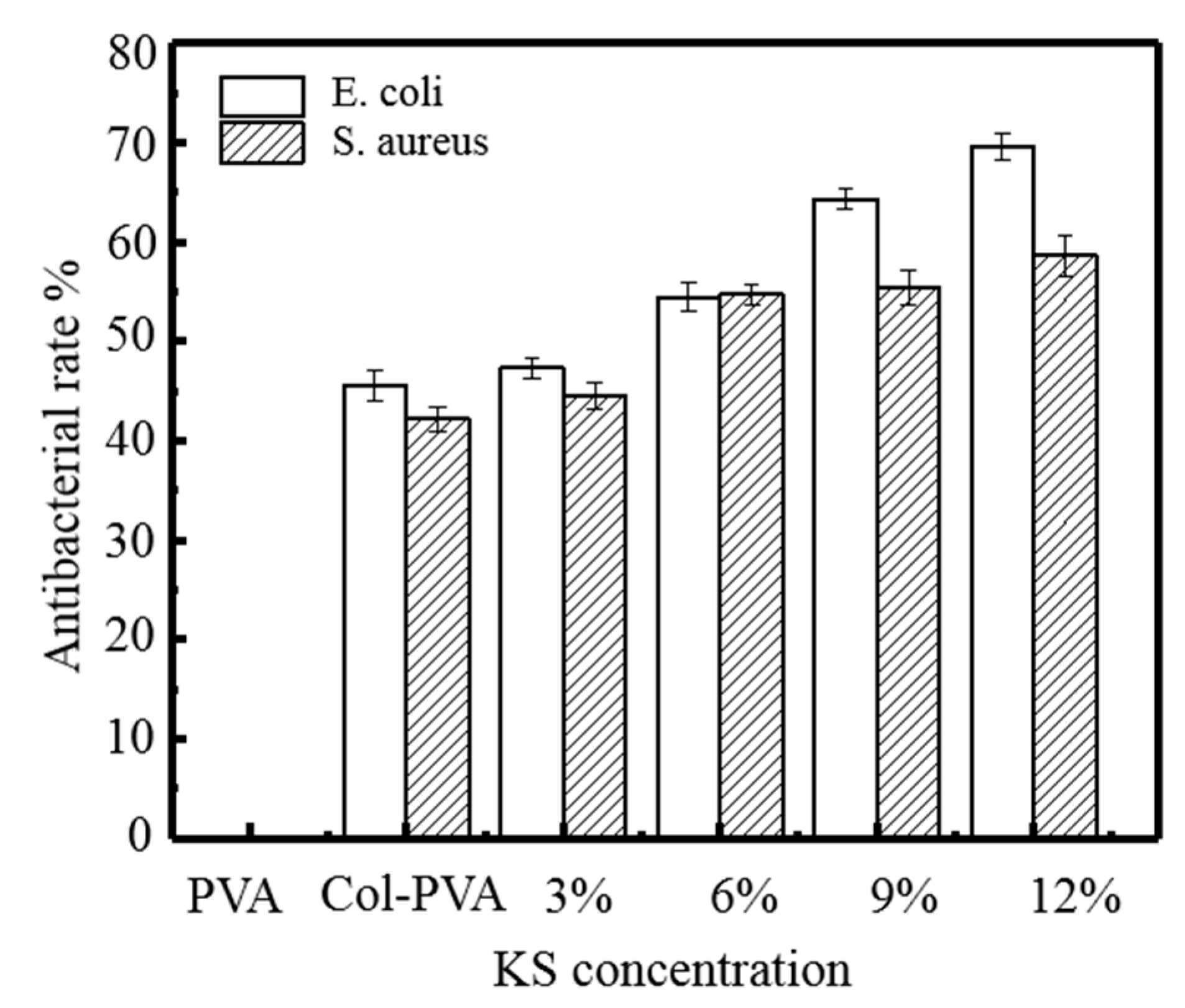
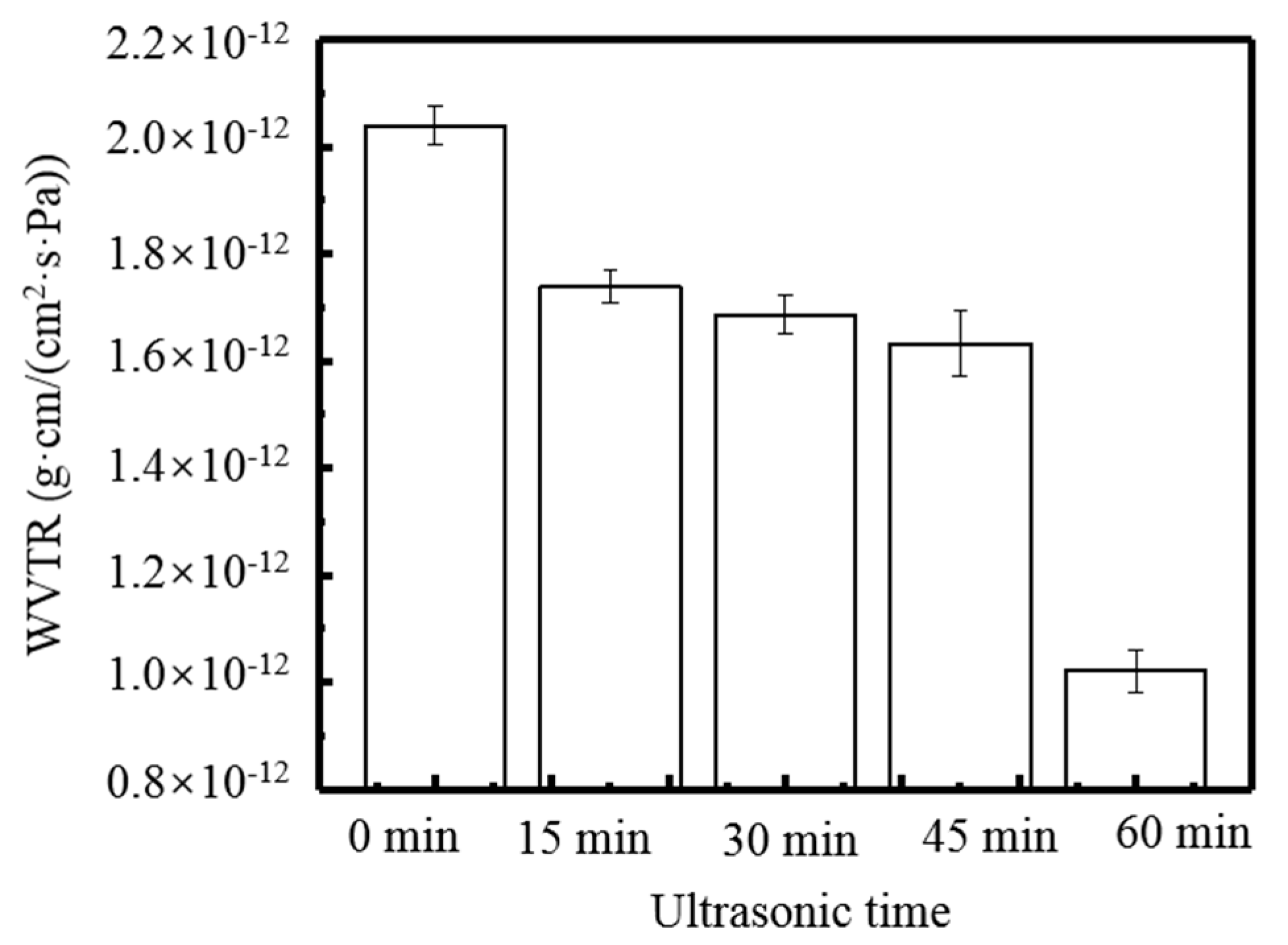
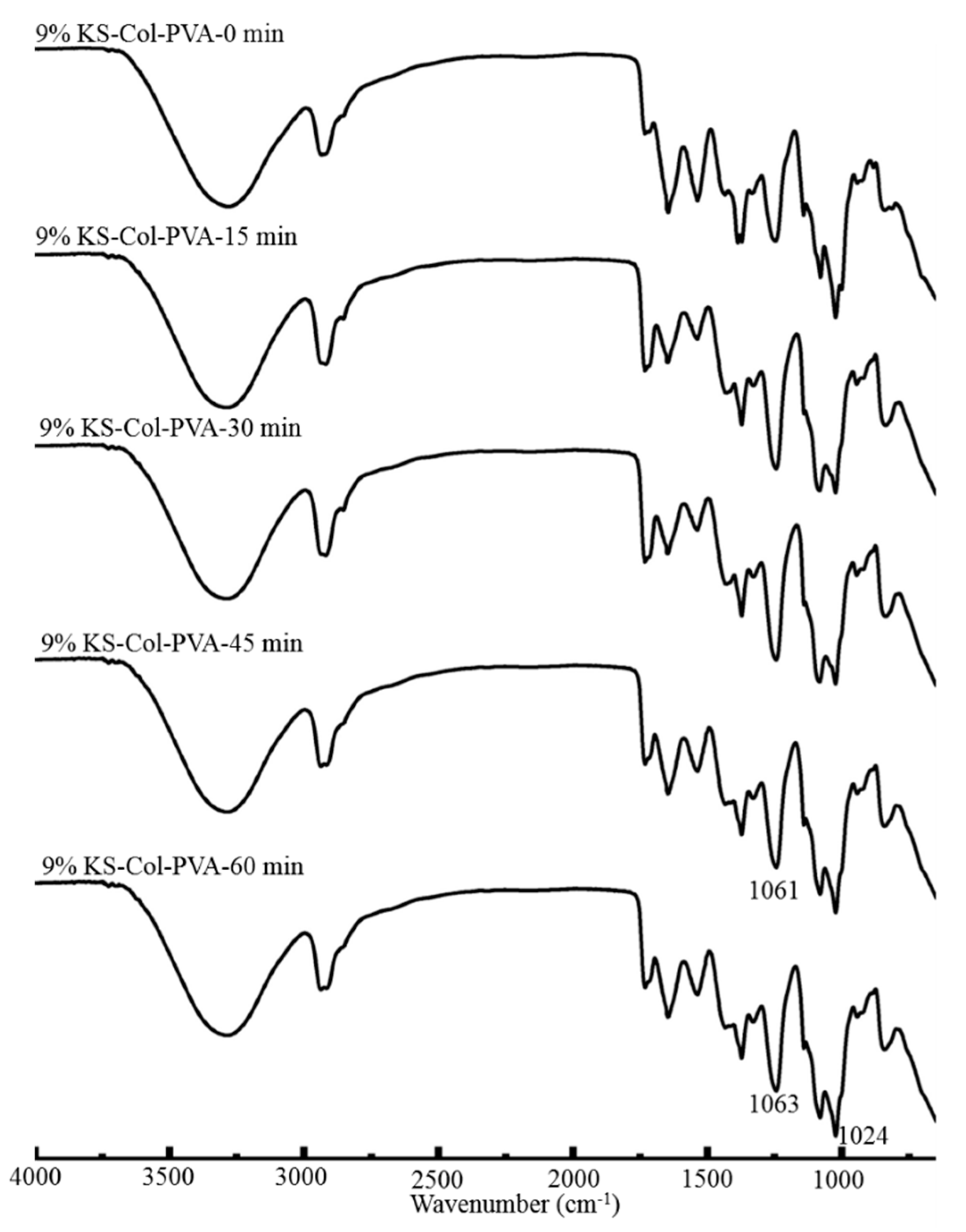

| Sample | AT (mm) | MC (%) | TS (MPa) | EAB (%) | T (%) | Color | |||
|---|---|---|---|---|---|---|---|---|---|
| L* | a* | b* | ΔE | ||||||
| PVA | 60.33 ± 2.52a | 5.9 ± 0.19a | 17.4 ± 0.9a | 14.35 ± 1.11a | 90.87 ± 0.50a | 85.28 ± 0.16a | 2.29 ± 0.17a | 3.74 ± 1.32a | 1.61 ± 0.16a |
| Col-PVA | 57.88 ± 3.79b | 16.1 ± 2.10b | 10.9 ± 1.2b | 4.35 ± 0.58b | 85.73 ± 2.29b | 83.38 ± 0.39b | 2.26 ± 0.15a | 7.39 ± 2.61b | 2.50 ± 0.16b |
| 3%KS | 59.67 ± 5.29a | 23.3 ± 2.98c | 6.8 ± 0.5c | 5.28 ± 0.43c | 88.70 ± 1.23a | 84.12 ± 0.16a | 2.28 ± 0.13a | 8.67 ± 3.06b | 2.67 ± 0.09b |
| 6%KS | 64.33 ± 4.16c | 17.9 ± 2.22b | 4.8 ± 0.6d | 5.43 ± 0.55c | 87.57 ± 0.95b | 82.52 ± 1.40b | 2.32 ± 0.19a | 9.68 ± 3.42b | 3.00 ± 0.78c |
| 9%KS | 60.00 ± 2.31a | 15.3 ± 1.78b | 3.3 ± 0.5d | 5.77 ± 0.51c | 87.80 ± 1.21b | 84.08 ± 0.19a | 2.26 ± 0.15a | 11.71 ± 4.14c | 2.78 ± 0.12b |
| 12%KS | 57.33 ± 3.06b | 15.2 ± 1.46b | 3.5 ± 0.8d | 5.49 ± 0.39c | 88.93 ± 0.45a | 84.64 ± 0.10a | 2.28 + 0.17a | 13.15 ± 4.65c | 2.98 ± 0.03c |
| Sample. | AT (mm) | MC (%) | TS (MPa) | EAB (%) | T (%) | Color | |||
|---|---|---|---|---|---|---|---|---|---|
| L* | a* | b* | △E | ||||||
| 9%-0 | 60.00 ± 2.31a | 15.3 ± 1.78a | 3.3 ± 0.5d | 5.77 ± 0.51c | 87.80 ± 1.21b | 84.08 ± 0.19a | 2.26 ± 0.15a | 11.71 ± 4.14a | 2.78 ± 0.12a |
| 9%-15 | 57.07 ± 3.61b | 16.7 ± 1.32a | 4.5 ± 0.33b | 14.48 ± 0.92a | 88.03 ± 0.25a | 83.89 ± 0.10a | 2.20 ± 0.10b | 15.66 ± 5.54b | 3.12 ± 0.29b |
| 9%-30 | 58.67 ± 1.15b | 14.2 ± 1.92a | 5.0 ± 0.52c | 13.85 ± 0.82a | 88.00 ± 0.72a | 82.86 ± 0.77b | 2.30 ± 0.18c | 17.53 ± 6.20c | 3.21 ± 0.28b |
| 9%-45 | 59.33 ± 2.65a | 13.6 ± 0.98b | 5.9 ± 0.10a | 13.13 ± 0.94a | 86.83 ± 0.40a | 82.80 ± 1.11b | 2.24 ± 0.19a | 18.53 ± 6.55c | 2.78 ± 0.08a |
| 9%-60 | 57.41 ± 3.46b | 14.8 ± 0.87a | 3.4 ± 0.21a | 13.02 ± 0.88a | 86.85 ± 0.21a | 84.25 ± 0.14a | 2.20 ± 0.10b | 21.11 ± 6.46d | 2.93 ± 0.13a |
| Sample | KS (g) | Col (g) | PVA (g) | Gly (g) |
|---|---|---|---|---|
| Pure-PVA | 0 | 0 | 4.8 | 2 |
| Col | 0 | 4.8 | 0 | 2 |
| Col-PVA | 0 | 2.4 | 2.4 | 2 |
| 3%KS-Col-PVA | 0.162 | 2.4 | 2.4 | 2 |
| 6%KS-Col-PVA | 0.324 | 2.4 | 2.4 | 2 |
| 9%KS-Col-PVA | 0.486 | 2.4 | 2.4 | 2 |
| 12%KS-Col-PVA | 0.648 | 2.4 | 2.4 | 2 |
© 2019 by the authors. Licensee MDPI, Basel, Switzerland. This article is an open access article distributed under the terms and conditions of the Creative Commons Attribution (CC BY) license (http://creativecommons.org/licenses/by/4.0/).
Share and Cite
Liang, X.; Feng, S.; Ahmed, S.; Qin, W.; Liu, Y. Effect of Potassium Sorbate and Ultrasonic Treatment on the Properties of Fish Scale Collagen/Polyvinyl Alcohol Composite Film. Molecules 2019, 24, 2363. https://doi.org/10.3390/molecules24132363
Liang X, Feng S, Ahmed S, Qin W, Liu Y. Effect of Potassium Sorbate and Ultrasonic Treatment on the Properties of Fish Scale Collagen/Polyvinyl Alcohol Composite Film. Molecules. 2019; 24(13):2363. https://doi.org/10.3390/molecules24132363
Chicago/Turabian StyleLiang, Xue, Shiyi Feng, Saeed Ahmed, Wen Qin, and Yaowen Liu. 2019. "Effect of Potassium Sorbate and Ultrasonic Treatment on the Properties of Fish Scale Collagen/Polyvinyl Alcohol Composite Film" Molecules 24, no. 13: 2363. https://doi.org/10.3390/molecules24132363
APA StyleLiang, X., Feng, S., Ahmed, S., Qin, W., & Liu, Y. (2019). Effect of Potassium Sorbate and Ultrasonic Treatment on the Properties of Fish Scale Collagen/Polyvinyl Alcohol Composite Film. Molecules, 24(13), 2363. https://doi.org/10.3390/molecules24132363





